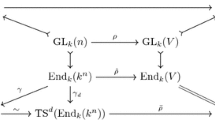Abstract
We define a graded graph, called the Schur–Weyl graph, which arises naturally when one considers simultaneously the RSK algorithm and the classical duality between representations of the symmetric and general linear groups. As one of the first applications of this graph, we give a new proof of the completeness of the list of discrete indecomposable characters of the infinite symmetric group.
Similar content being viewed by others
References
P. Alexandersson, The symmetric functions catalog,, https://www2.math.upenn.edu/~peal/polynomials/tableauOperators.htm#RSKvsDualRSK.
A. Berele and A. Regev, “Hook Young diagrams with applications to combinatorics and to representations of Lie superalgebras”, Adv. in Math., 64:2 (1987), 118–175.
A. Borodin and G. Olshanski, Representations of the Infinite Symmetric Group, Cambridge University Press, Cambridge, 2017.
W. Fulton, Young Tableaux With Applications to Representation Theory and Geometry, Cambridge University Press, Cambridge, 1977.
D. Grinberg, Notes on the combinatorial fundamentals of algebra, arXiv: 2008.09862.
S. V. Kerov, Asymptotic Representation Theory of the Symmetric Group and its Applications in Analysis, Amer. Math. Soc., Providence, RI, 2003.
S. Kerov, A. Okounkov, and G. Olshanski, “The boundary of the Young graph with Jack edge multiplicities”, Internat. Math. Res. Notices, :4 (1998), 173–199.
S. V. Kerov and A. M. Vershik, “The characters of the infinite symmetric group and probability properties of the Robinson–Schensted–Knuth algorithm”, SIAM J. Algebraic Discrete Methods, 7:1 (1986), 116–124.
A. Lascoux, B. Leclerc, and J.-Y. Thibon, “The plactic monoid”, Algebraic Combinatorics on Words, Cambridge University Press, Cambridge, 2002, Chapter 6.
A. Yu. Okounkov, “Thoma’s theorem and representations of the infinite bisymmetric group”, Funkts. Anal. Prilozhen., 28:2 (1994), 31–40; English transl.:, Functional Anal. Appl., 28:2 (1994), 100–107.
D. Romik and P. Śniady, “Jeu de taquin dynamics on infinite Young tableaux and second class particles”, Ann. Probab., 43:2 (2015), 682–737.
P. Śniady, “Robinson–Schensted–Knuth algorithm, jeu de taquin, and Kerov–Vershik measures on infinite tableaux”, SIAM J. Discrete Math., 28:2 (2014), 598–630.
R. Stanley, Enumerative Combinatorics, Cambridge University Press, Cambridge, 1999.
E. Thoma, “Die unzerlegbaren, positiv-definiten Klassenfunktionen der abzählbar unendlichen, symmetrischen Gruppe”, Math. Z., 85 (1964), 40–61.
A. M. Vershik, “Description of invariant measures for the actions of some infinite-dimensional groups”, Dokl. Akad. Nauk SSSR, 218:4 (1974), 749–752; English transl.:, Soviet Math. Dokl., 15:4 (1974), 1396–1400.
A. M. Vershik, “Three theorems on the uniqueness of the Plancherel measure from different viewpoints”, Trudy MIAN, 305 (2019), 71–85; English transl.:, Proc. Steklov Inst. Math., 305 (2019), 63–77.
A. M. Vershik, “Combinatorial encoding of Bernoulli schemes and the asymptotic behavior of Young tableaux”, Funkts. Anal. Prilozhen., 54:2 (2020), 3–24; English transl.:, Functional Anal. Appl., 54:2 (2020), 77–92.
A. M. Vershik, “A method of defining central and Gibbs measures and the ergodic method”, Dokl. Ross. Akad. Nauk, 497:1 (2021), 7–11; English transl.:, Dokl. Math., 103:2 (2021), 72–75.
A. M. Vershik, “Groups generated by involutions, numbering of posets, and central measures”, Uspekhi Mat. Nauk, 76:4 (2021); English transl.:, Russian Math. Surveys, 76:5(461) (2021).
A. M. Vershik and S. V. Kerov, “Asymptotic theory of characters of the symmetric group”, Funkts. Anal. Prilozhen., 15:4 (1981), 15–27; English transl.:, Functional Anal. Appl., 15:4 (1981), 246–255.
A. M. Vershik and N. V. Tsilevich, “Ergodicity and totality of partitions associated with the RSK correspondence”, Funkts. Anal. Prilozhen., 55:1 (2021), 33–42; English transl.:, Functional Anal. Appl., 55:1 (2021).
Funding
This work was supported by the Russian Science Foundation grant no. 21-11-00152.
Author information
Authors and Affiliations
Corresponding authors
Additional information
Translated from Funktsional'nyi Analiz i ego Prilozheniya, 2021, Vol. 55, pp. 26–41 https://doi.org/10.4213/faa3917.
To the memory of S. V. Kerov (12.06.1946–30.07.2000)
Translated by N. V. Tsilevich
Rights and permissions
About this article
Cite this article
Vershik, A.M., Tsilevich, N.V. The Schur–Weyl Graph and Thoma’s Theorem. Funct Anal Its Appl 55, 198–209 (2021). https://doi.org/10.1134/S0016266321030023
Received:
Revised:
Accepted:
Published:
Issue Date:
DOI: https://doi.org/10.1134/S0016266321030023



